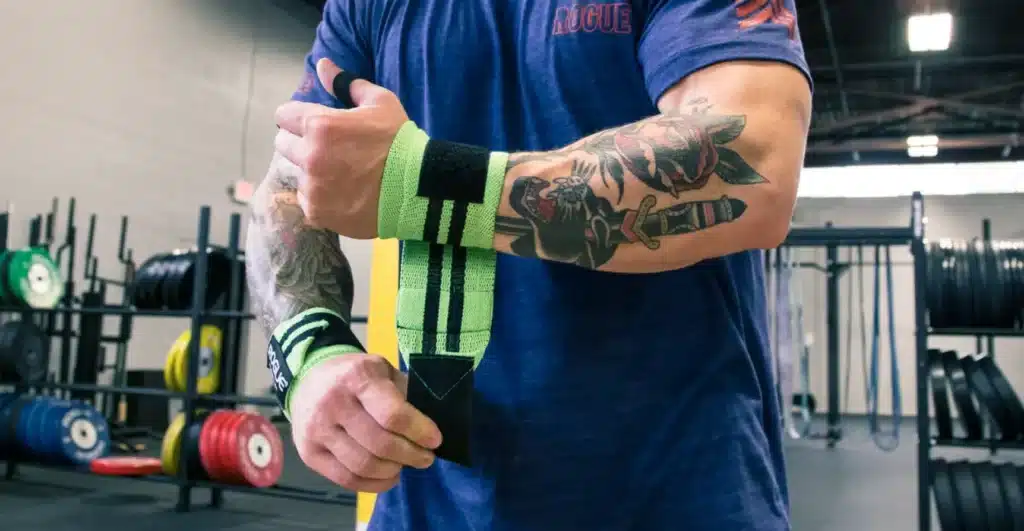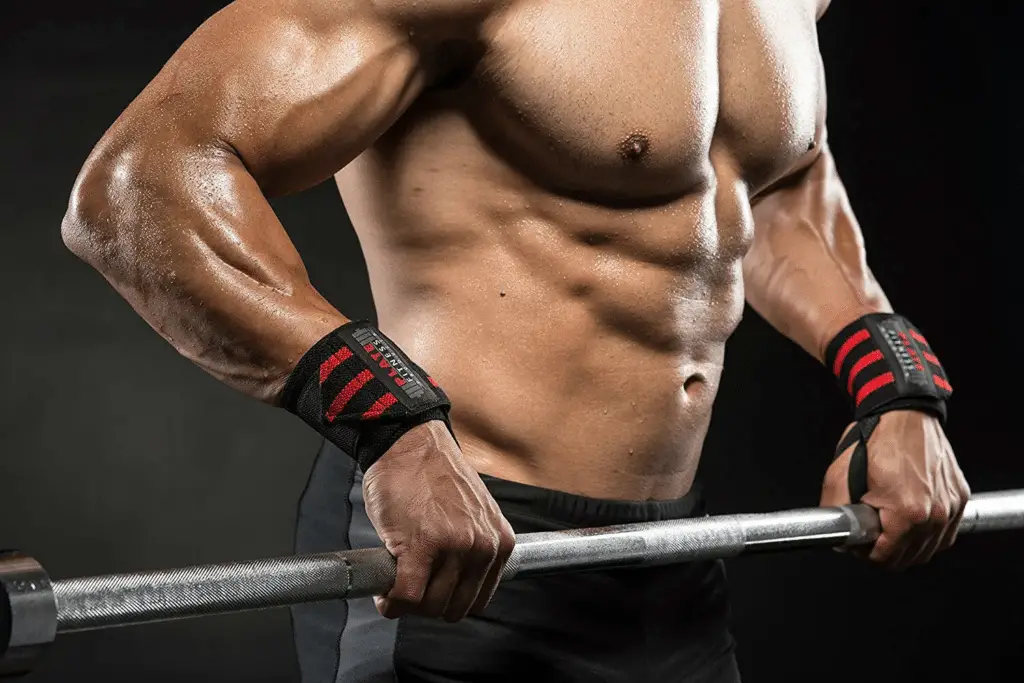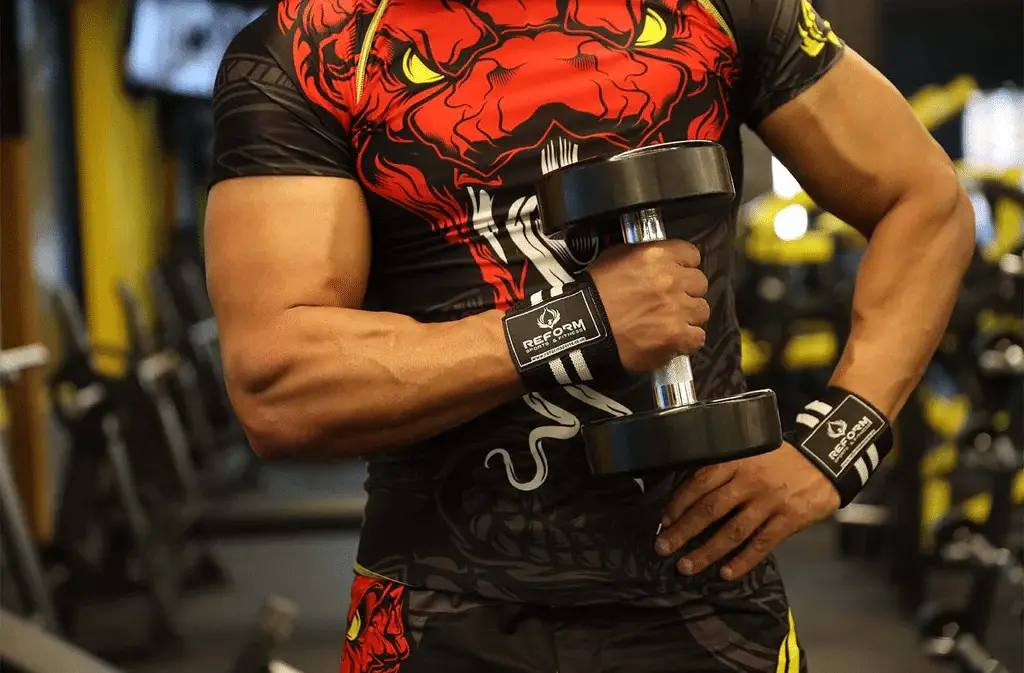Introduction
How To Use Wrist Straps For Weightlifting: Weightlifting is a demanding and rewarding discipline that places substantial stress on the body, particularly the wrists, when handling heavy weights. To enhance grip strength and wrist support during lifts, many weightlifters turn to a valuable accessory known as wrist straps. These small but crucial tools are designed to secure the wrist and prevent overextension, allowing lifters to focus on their form and target muscles without the distraction of a weak grip.
Wrist straps are particularly helpful for exercises like deadlifts, heavy rows, and pull-ups, where maintaining a solid grip is essential to prevent the bar from slipping or to reduce stress on the wrists. By understanding the correct application and usage of wrist straps, weightlifters can safely and effectively incorporate them into their workouts, unlocking the potential for heavier lifts and greater muscle engagement.
Whether you’re an experienced lifter looking to fine-tune your form or a beginner aiming to improve your grip strength, this guide will help you harness the benefits of wrist straps for your weightlifting journey. Wrist straps offer an additional layer of support that can be particularly beneficial during heavy lifts, ensuring that your wrists remain stable and aligned. However, to harness their advantages, it’s essential to understand the different types of wrist straps available, the circumstances in which to use them, and the proper techniques for application.

Are wrist straps good for weightlifting?
Stabilize and Support: wearing weightlifting gloves with wrist straps helps to stabilize and support the wrists due to the straps keeping the wrists in a neutral position. This can help prevent injury because it ensures the wrist is correctly placed on the bar and helps to prevent hyperextension.
Heavy Deadlifts: Deadlifting heavy weights can be particularly taxing on your grip strength. Wrist straps can help you maintain a secure grip on the bar, allowing you to lift more weight and focus on the targeted muscle groups without worrying about your grip failing.
Pull-Ups and Chin-Ups: For those aiming to increase their pull-up or chin-up repetitions or to target specific back muscles, wrist straps can alleviate forearm fatigue, making it easier to perform more repetitions.
Rows: Rows, whether barbell or dumbbell variations, can benefit from wrist straps, especially as the weights get heavier. This added support can help you maintain proper form and isolate the muscles you want to target without being limited by your grip.
High Repetition Sets: During high-repetition sets, your grip can give out before your target muscles are fully fatigued. Wrist straps can be useful in such cases to maintain consistency and avoid having to stop the set prematurely due to grip failure.
Injury Rehabilitation: If you have a wrist or hand injury, wrist straps can help reduce stress on the injured area while still allowing you to continue training.
Should I deadlift with wrist straps?
This also may tire out your forearm muscles faster and could possibly be a detriment to your grip strength if used for multiple sets in a workout. So I recommend only doing this for max effort attempts or max testing in training. Otherwise, avoid using wrist wraps in training for deadlifts.
When to Use Wrist Straps for Deadlifting
Heavy Deadlifts: If you’re lifting extremely heavy weights and your grip strength is the limiting factor, wrist straps can be a valuable tool to help you maintain a secure grip on the bar. This can enable you to focus on your overall lifting technique and the targeted muscle groups, particularly when your grip strength is challenged.
Progressive Overload: If your primary goal is to progressively increase the weight you lift in the deadlift and your grip strength is struggling to keep pace with your overall strength gains, wrist straps can help bridge the gap and allow for continued progression.
Reducing Grip Fatigue: During high-intensity or high-volume training sessions, grip fatigue can set in before the target muscles are fully fatigued. Wrist straps can alleviate this issue and help you complete your sets with good form.
When Not to Use Wrist Straps
Form and Technique: Wrist straps should not be used as a substitute for proper form and technique. Learning and maintaining correct deadlift form is essential for preventing injuries.
Grip Strength Development: If you’re actively working on developing your grip strength, avoid relying on wrist straps too frequently, as they can hinder this natural progression. You can include specific grip-strengthening exercises in your routine to build a strong grip.
Moderate and Light Lifts: For moderate or light deadlifts that do not challenge your grip, it’s generally unnecessary to use wrist straps. You can save them for heavy or high-intensity lifts where grip becomes a limiting factor.
Balanced Training: Keep in mind that a well-rounded strength training program should focus on overall physical development, not just lifting the heaviest weights. While wrist straps can help you lift more, they should be used mindfully and selectively to achieve your specific goals.
When should I start lifting straps?
It is usually recommended to wait until 3 months of lifting to allow your grip strength to improve before using straps or Power Grips. Intermediate lifters can use straps on most pull exercises, but due to safety concerns they should be avoided on certain overhead movements.
Strength and Skill Development: When you’re relatively new to weightlifting, it’s important to focus on developing your strength, grip, and technique without relying on lifting straps. Initially, try to lift weights without straps to build your grip strength and develop better lifting form.
Intermediate and Advanced Lifters: Lifting straps can be particularly beneficial for intermediate to advanced lifters who are working with heavier weights or performing exercises where grip strength becomes a limiting factor. Straps can help you maintain your form and complete your sets when your grip starts to fatigue.
Isolation Exercises: Lifting straps can be used during isolation exercises, like bicep curls or lat pulldowns, to isolate the target muscle group and minimize the involvement of the forearm muscles. This can be especially useful if you’re trying to target specific muscles and want to reduce grip fatigue.
Deadlifts and Pulls: Many lifters use lifting straps when performing deadlifts and pulling exercises like rows and shrugs. These exercises can be very grip-intensive, and straps can help prevent grip fatigue, allowing you to work on your posterior chain muscles effectively.
Balanced Approach: It’s important to strike a balance. While lifting straps can be helpful, you should not use them exclusively or too early in your training. Consider using them for the most demanding sets or exercises while continuing to develop your natural grip strength.
Warm-up and Accessory Work: You can also use lifting straps during warm-up sets or for accessory exercises where grip strength is not a primary concern. This can help you conserve your grip strength for the main lifts.
What are the benefits of wrist straps?
The primary benefit of wrist wraps is to help stabilize the wrist to prevent hyperextending and promote proper wrist placement under the bar. With wrist wraps, you can better stabilize barbell weight and prevent sapping any strength from your shoulders or legs for corrective movements.
Improved Grip: Wrist straps can significantly enhance your grip strength and stability when lifting heavy weights. They allow you to secure the barbell or dumbbell firmly, reducing the risk of dropping the weight during exercises like deadlifts, rows, and pull-ups.
Increased Repetitions: With a more secure grip, you can often perform more repetitions and lift heavier weights, which can lead to greater muscle engagement and hypertrophy. This can be especially beneficial for bodybuilders and powerlifters looking to maximize their muscle development and strength gains.
Reduced Forearm Fatigue: Lifting straps can reduce the strain on your forearm muscles during exercises that heavily involve grip strength. This is particularly useful for lifters who experience grip fatigue before fully targeting their target muscle groups.
Enhanced Focus on Target Muscles: By minimizing the involvement of your grip, wrist straps can help you concentrate more on the intended muscle groups during compound movements. This is particularly valuable during exercises like lat pulldowns and rows, allowing you to isolate and work the targeted muscles effectively.
Injury Prevention: Lifting straps can potentially lower the risk of injuries that may occur due to grip failure or compensatory movements when trying to maintain grip. This can help maintain proper lifting form and reduce the risk of muscle strains.
Support During Rehabilitation: For individuals recovering from wrist or hand injuries, wrist straps can provide additional support and stability when returning to lifting exercises, allowing them to ease back into their training regimen more comfortably.
Longer Time Under Tension: With a more secure grip, you can control the weight through a full range of motion, leading to more time under tension for your muscles. This can contribute to muscle growth and development.
What exercises to use wrist straps?
We emphasize heavy because you shouldn’t rely on wrist straps all the time. You still want to maintain good grip strength, so do not use them for warm-ups or for lighter sets. Here are a few common exercises straps are used for: Deadlifting – Romanian deadlifts, sumo deadlifts, any other deadlifting variations.
Deadlifts: Deadlifts are one of the primary exercises where wrist straps are commonly used. When lifting heavy weights, grip strength can become a limiting factor, and wrist straps can help you maintain a secure grip throughout the set.
Barbell Rows: Barbell rows, whether they’re bent-over rows or Pendlay rows, can also benefit from wrist straps, especially if you’re lifting heavy weights. Straps can help you focus on engaging the back muscles without grip fatigue becoming an issue.
Pull-Ups and Chin-Ups: For individuals who struggle with grip strength during pull-ups and chin-ups, wrist straps can assist in maintaining a secure grip on the bar, allowing you to complete more repetitions and target the lats effectively.
Lat Pulldowns: Using wrist straps for lat pulldowns can help isolate the latissimus dorsi muscles, ensuring that grip strength doesn’t limit your ability to work on your back muscles.
Shrugs: When performing heavy shrugs, wrist straps can be particularly beneficial. These straps allow you to hold and lift heavier weights, targeting the upper traps and shoulder muscles effectively.
Farmer’s Walks: Wrist straps can be used for farmer’s walks, which involve carrying heavy weights in each hand. This exercise challenges grip strength, and straps can help you focus on the benefits of the exercise rather than worrying about your grip.
Dumbbell Rows: When using heavy dumbbells for rows, wrist straps can assist in maintaining a secure grip, especially if your grip strength is a limiting factor.
Heavy Dumbbell Presses: If you’re lifting heavy dumbbells for shoulder presses, bench presses, or incline presses, wrist straps can help you focus on your pressing strength without worrying about your grip.
Rack Pulls: In exercises like rack pulls, where you’re lifting heavy weights with a partial range of motion, wrist straps can help you hold onto the bar securely.
What is the difference between wrist wraps and straps?
Wraps loop over your wrists several times to provide compression and keep the joints stable during your training. In contrast, lifting straps support your grip and allow you to hold more weight on various exercises, such as deadlifts, shrugs, and bent-over rows.
Wrist Wraps
Support for the Wrists: Wrist wraps are designed to provide support and stability to the wrists. They are typically made of a stretchy material, such as cloth or elastic, and are wrapped around the wrists to help keep them in a neutral position during exercises.
Injury Prevention: Wrist wraps are often used to prevent wrist injuries or provide support to individuals with existing wrist issues. They can help reduce the risk of wrist hyperextension or excessive flexion during lifting.
Wrist Alignment: Wrist wraps assist in maintaining proper wrist alignment and reduce the risk of hyperextending the wrists, which can be common during exercises like overhead presses and heavy bench presses.
Common Exercises: Wrist wraps are typically used during exercises that involve the wrists and require wrist stability, such as bench presses, overhead presses, and Olympic weightlifting movements like the snatch and clean and jerk.
Wrist Straps (Lifting Straps)
Grip Assistance: Wrist straps, or lifting straps, are primarily designed to improve grip strength and prevent grip fatigue during lifting. They consist of a strap or piece of material that wraps around the barbell or dumbbell handle and your wrist to help secure the grip.
Lifting Heavy Weights: Lifting straps are especially useful when you’re lifting very heavy weights or performing exercises where grip strength can be a limiting factor, such as deadlifts, barbell rows, or pull-ups.
Isolation of Target Muscles: Lifting straps can allow you to isolate and target specific muscle groups effectively by taking the focus off your grip and directing it toward the intended muscles.
Reduced Forearm Fatigue: By using lifting straps, you can reduce forearm and grip fatigue, enabling you to complete more repetitions or lift heavier weights.
Are wrist wraps good for beginners?
They’re not only unnecessary for novice lifters, they also get in the way of beginners learning how to maintain an optimal and safe wrist position naturally. However, if you’re working with weights that exceed your body weight or have a history of wrist issues, wrist wraps might be a smart investment, explains Samuel.
Wrist Stability and Injury Prevention: Beginners may benefit from wrist wraps if they have pre-existing wrist issues or if they are involved in exercises that place a significant demand on the wrists. Wrist wraps can help maintain proper wrist alignment, reduce the risk of hyperextension, and provide added support, which can be particularly important when starting a new exercise regimen.
Heavy Compound Lifts: If you’re a beginner and are engaging in heavy compound lifts like the bench press or overhead press, wrist wraps can help stabilize your wrists and reduce the risk of injury, especially if you’re not yet accustomed to these movements.
Personal Comfort: Some beginners find that wrist wraps provide added comfort and confidence during their workouts, helping them feel more secure and supported while lifting.
Are lifting straps better than gloves?
If you are seeking a lifting gear that will aid in developing a more extensive and robust back, then lifting straps are your best friend. On the other hand, lifting gloves are a better alternative for you if you are worried about superior padding, enhanced grip, wrist support, calluses protection, and convenience.
Lifting Straps
Purpose: Lifting straps are primarily designed to improve grip strength and prevent grip fatigue during heavy lifting. They are particularly useful for exercises where maintaining a secure grip is challenging, such as deadlifts, barbell rows, and pull-ups.
Grip Enhancement: Lifting straps provide a direct enhancement to your grip by securing the bar or weight to your wrist. This allows you to lift heavier weights or complete more repetitions without relying solely on your grip strength.
Isolation and Targeting: Lifting straps can help you isolate and target specific muscle groups more effectively by minimizing the role of your grip. This can be especially beneficial for bodybuilders or individuals focusing on muscle development.
Reduced Forearm Fatigue: Straps reduce forearm and grip fatigue, enabling you to maintain proper form and continue working on your target muscle groups.
Lifting Gloves
Purpose: Lifting gloves are designed to protect your hands, particularly your palms and fingers, from blisters, calluses, and skin irritation when lifting weights.
Hand Protection: Lifting gloves provide a barrier between your hands and the rough surfaces of weights and bars, reducing the risk of developing painful blisters or calluses.
Grip Enhancement: While lifting gloves offer some additional grip, they do not enhance grip strength to the same extent as lifting straps. The grip enhancement is typically achieved through the material on the palm.
Comfort and Hygiene: Lifting gloves can improve comfort during your workouts by reducing friction between your hands and the equipment. They also help maintain hygiene by preventing sweat from accumulating on weights and bars.

Conclusion
Wrist straps can be valuable tools for weightlifters, providing additional support and stability during heavy lifts. By following the right techniques and guidelines, you can maximize their benefits while ensuring safety. First and foremost, it’s essential to choose the appropriate wrist straps for your specific needs and preferences. Whether you opt for traditional cotton or modern nylon straps, selecting the right length and width can make a significant difference in your lifting experience. Make sure to adjust them snugly but not overly tight to maintain circulation and comfort.
Proper technique and wrist positioning are critical when using wrist straps. These straps should serve as supplementary support, not a crutch, so continue to prioritize grip strength and forearm development through other exercises. And remember, wrist straps should not be relied upon excessively, as developing your grip strength naturally is an essential part of weightlifting. Wrist straps can be a useful addition to your training arsenal, but they should complement, not replace, the development of your grip and overall strength. When used thoughtfully, they can help you reach new heights in your weightlifting journey while minimizing the risk of grip fatigue or injury.
Incorporating wrist straps as part of your weightlifting gear can enhance your performance and help you achieve your fitness goals, but always use them thoughtfully and with the aim of enhancing your lifting experience, not replacing the development of your natural grip strength. Proper form, technique, and a well-rounded strength training program should remain at the core of your weightlifting journey, with wrist straps serving as a supportive tool when needed.

